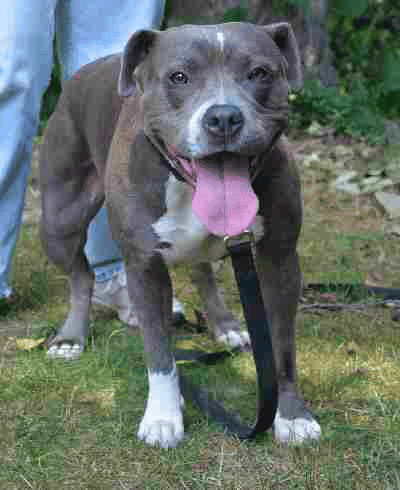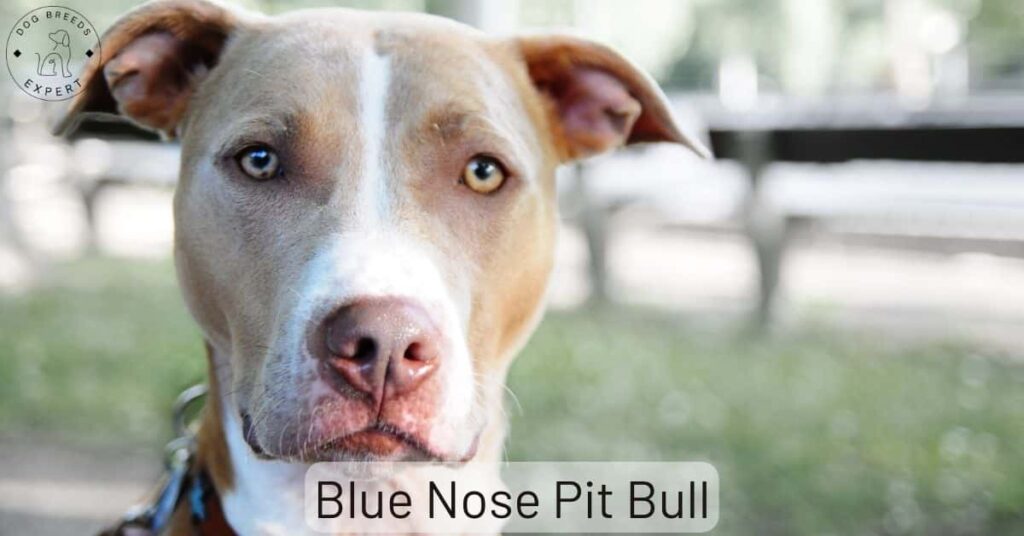Blue Nose Pit Bulls: Intimidating Looking, Loyal, Sensitive.
Blue nose pit bulls may be the latest in breeder inventions, but are they the breed for you?
Their name and appearance are a bit deceiving. Blue nose pit bulls are actually extremely loving, loyal, and even good with children.

This particular breed of dog was NOT bred to be aggressive or to fight, which is a common misconception with many dog breeds, especially the blue nose pit-bull.
This fallacy arose because pit bulls were sometimes used in dogfights, after being brought up and trained to fight by criminals who just wanted to make money. This has given the pit bull an aggressive and scary reputation.
You will see many pit bulls in pounds and kennels simply because people are too scared to give these guys a proper chance. Some jurisdictions continue to ban all pit bulls from their location.
The name “Pit Bull” does not refer to just one breed of dog. This is confusing. In fact, the only dog breed with the words “pit bull” in the name is the American Pit Bull Terrier.
But 3 other dog breeds are commonly referred to as pit bulls; The American Staffordshire Terrier, the Staffordshire Bull Terrier, and also the American Bulldog. The Blue Nose Pit Bull is a recent breeder’s invention.
Blue nose pit bulls are usually either American Staffordshire Terriers or American Pitbull Terriers. Or they are a cross between the two. Breeders were trying to get a dog with a blue-grey coat, and the nose color was accidental.
They are not a distinct and separate breed from the Pit bull, and their “blue” nose is actually caused by recessive genes that produce the pigmentation.
Surprisingly, blue nose pit bulls, in fact, do NOT have a nose that is truly blue. Their noses are more of a grey tone with a tint of blue to them, instead of a normal black nose. This makes this breed different to the standard pit bull, with a black nose.
They can look a little bit intimidating at first glance, but once you bring one of these dogs into your house, you might just find that these dogs are perfect for you!
Their Blue Noses

With this being said, your blue nose Pit-bull does not even have to have a blue nose at all. They can actually sport a blue, grey, black, or even a red nose and still be a blue nose Pit-bull.
The differentiation in color does not pose as a flaw or imperfection to the breed, which is something to keep in mind.
The unique “blue-grey” tone is due to the recessive phenotypes shining through and being produced.
Genetics of Blue Noses

The American Dog Breeders Association (ADBA) states that the blue coloration results from a homozygous recessive gene. The red-nose dog also results from recessive genetic traits.
To explain that in a more simple way, each mother and father Pitbull have dominant genes that will shine through over a recessive gene, such as the black nose, and a grey coat.
Dominant genes are the more typical and common characteristics and features we see in our breeds. Recessive genes are the more rare and unique features we see, such as a blue coat or a blue nose.
Dominant genes are expressed in capital letters while recessive genes are expressed in lowercase letters. We call these letters the genotype and what you see, the phenotype.
For example color genetics tells us that there are three possible options when it comes to the blue or black color inheritance, all identified with letters of the alphabet: BB, Bb, and bb.
For a blue nose Pit bull to even be possible, both parents would need to carry a lowercase letter or a recessive gene (bb).
For a very simple explanation, you can use a punnet square: Both parents have black noses but carry a recessive gene for a blue nose.
In this very simplified example of Mendelian genetics, the litter that resulted from these parents would look like this:
- There is 25% chance that a puppy would be pure for a black nose
- There is 50% chance that a puppy would have a black nose but carry a gene for a brown nose.
- There is 25% chance that a puppy will have a blue nose.
Remember this is all in percentages of any given puppy. It does not mean that out of a litter of 8 puppies, two will have blue noses, 2 will be dominant for black noses and 4 will have black noses and carry a recessive gene.
This can be hard to wrap your head around, especially if you do not have any prior knowledge of the biology or genetics field, but there are plenty of lessons and teachers online that can help you learn more about it if you are curious.
However, if you could not care less about how your blue nose Pit bull came to be, then just know that either way they are very special and special dogs that were made just for you.
This is a very sturdy and broad chested dog, which has strong legs, and is set very close to the ground.
They have a very confident stance and can look very intimidating to people at times, but it it’s important to know that these are just giant teddy bears and are extremely sociable and kind.
This is an excellent breed for kids and active families. All in all, if these dogs are raised in a good household with a healthy diet, they will be your best friends.
These dogs are extremely sociable and friendly and will relate to you and understand you like no other dog will.

They may require a little bit more work when it comes to training, but it is worth it if you want a loyal friend for life, who will be by your side no matter what.
Something that is interesting about this breed is that they seem to have emotions that are very similar to human emotions.
They have the ability to make rational as well as irrational decisions, which is unique to this breed
The blue nose Pitbull is one of the most sensitive dogs in the world. With this being said, they will relate to their owner extremely well and be very kind and loyal.
However, they also can be stubborn and get their feelings hurt as well. It is a very similar situation to having a teenage child in your house. Kind, gentle training is a must.
These dogs adapt really well to most environments and get along really well with children.
When it comes to other dogs, these guys can be a bit stubborn. Since they crave all your attention, they can tend to become jealous when another dog is brought into the picture.
If you train and socialize this breed as a puppy, they are more likely to be able to get along with other dogs, than if you were to buy an adult pit bull.
This is one of the most active dog breeds in the world, and they require a lot of exercises to keep them healthy and happy.
Without the proper amount of exercise, they will become high strung and can even be aggressive. Keep this in mind when you’re thinking about bringing a blue nose pit-bull into your home.
Vital Statistics of Blue Nose Pit Bulls
The name, “Pit Bull”, is given to several distinct breeds.
American Pit Bull Terrier
Origin: United States
Size: Varies
Grooming: Minimal
Training: Average
Recognition
UKC: Terriers

Staffordshire Bull Terrier
Weight: 24-37 lb 11-17 kg
Height: 14-16 in 36-41 cm
Life Expectancy: 12-14 years

American Staffordshire Terrier
Weight: 37-44 lb (17-20 kg)
Height: 18-19 inches (46-48 cm)
Life Expectancy: Up to 15 years
Recognition
FCI: Group 3
AKC: Terriers
ANKC: Terriers
CKC: Terriers
NZKC: Terriers

American Bull Dog
The American Bull Dog is often mistaken for a Pit Bull also.

Ease of Training: Blue Nose Pit Bulls
Blue nose pit bulls are brilliant which is sometimes hard to believe since this breed has particularly silly faces at times. They are very easy to train because they are smart enough to understand and remember instructions.
However, they can also be stubborn during training if they do not feel like they are getting their way, which can be a little bit difficult at times. Obedience training is highly recommended for this particular breed of dog.
Protection Provided by Blue Nose Pit Bulls
Strangely enough, they do not make good guard dogs. This can be confusing since physically this is a very sturdy and aggressive looking breed.
Great guard dogs have a couple of things in common:
- They are big, strong, and foreboding
- They are wary of strangers and normally not friendly to anyone they don’t know.
This is a breed that loves all people and will offer a wagging tail and lots of kisses to anyone. They are not likely to provide much protection for you.
Grooming Blue Nose Pit Bulls

Grooming is a breeze for these dogs. Since they have a short coat, a once over brushing may be enough on a weekly basis.
They will need to have their teeth brushed regularly and ears checked and cleaned as needed. Their nails grow quickly, so they should be trimmed or filed down using a grinder or metal file.
Other than that, the most important grooming task is to keep a vigilant eye on any kind of skin irritation or rash that might develop.
They are prone to skin problems, so checking them out once a day will prevent any potential concerns from turning into full-blown problems.
Health Considerations of Blue Nose Pit Bulls
The blue nose Pit bull is a relatively healthy breed, but they are prone to skin diseases such as mange, which is a skin disease caused by parasitic mites.
Symptoms of mange are hair loss, excessive itching, and the formation of scabs or lesions.
Since this breed is derived from a relatively small gene pool, they are in general prone to more genetic problems.
Make sure you tell your vet if you see anything abnormal with your dog or if you suspect something, especially with their skin.
Breeders have been trying to eliminate undesirable traits for years and years, which can lead to health issues in general.
Breeds of dogs that have repeatedly been bred over and over are prone to deafness, low vision, and sometimes temperament issues. Keep this is mind when looking for a breeder.
Only purchase from a reputable breeder that is conscientious and performs genetic tests before a mating.
The diet is a crucial factor with this breed. As they are growing, a diet of protein and raw food items is important in assuring that your dog has a better skin coat, reduces the chance of skin problems, and also makes their muscles stronger which will result in an overall better adult dog for you.
Without the proper diet and exercise, this dog can become lethargic and unhealthy. Keep this in mind when thinking about adopting or buying one of these little guys.
Reference and Further Reading
There is much controversy over Pit Bulls due to their historic past and how they were originally used. If you are set on a pit bull, you should do your due diligence. The name “Pit Bull” describes more than one breed, so may we suggest you look into those breeds that make up the loosely defined category of Pit Bull.
Return to Dog Breeds List B.



